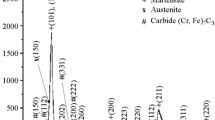Summary
The abrasive wear resistance of a large group of cast steel and white iron grinding mill liners was studied using a combination of service and laboratory testing. The hardness of the liners was the metallurgical variable which correlated best with the weight losses experienced during both service exposure and pin abrasion tests. Chemical and microstructural variations were much less significant in their effect upon the relative wear within the groups of either steel or iron liners, although such variations were important in the basis for the markedly lower laboratory wear rate of the white iron liners as a group. A strong correlation was found between the weight losses measured in laboratory tests and in service, and thus it appears possible to predict the service performance of new liner materials in the subject application based upon prior laboratory testing.
Similar content being viewed by others
References
D. E. Diesburg and F. Borik, “Optimizing Abrasion Resistance and Toughness in Steels and Irons for the Mining Industry,” in Materials for the Mining Industry, edited by R. Q. Barr, Climax Molybdenum Company, Ann Arbor, Michigan, 1974, pp. 15–41.
J. Dodd and D. J. Dunn, “High Chromium-Molybdenum Alloy Irons for the Mining Industry,” Molybdenum Mosaic, 3(2) (1978), pp. 2–9.
J. M. Bereza, “Wear and Impact Resistant White Cast Irons,” British Foundryman, 74(10) (1981), pp. 205–211.
H. L. Arnson, J. L. Parks, and D. R. Larsen, “Alloys and Designs for Large Mill Liners and Crusher Parts,” AIME Intermountain Minerals Conference, Vail, Colorado, August 1982.
C. J. Wilson, “Evolutionary Improvement of the ‘Old’ & the Development of New Wear Resistant Materials in Mill Liners and Cast Grinding Balls,” AIME Intermountain Minerals Conference, Vail, Colorado, August 1982.
T. E. Norman, “A Review of Materials for Grinding Mill Liners,” in Materials for the Mining Industry, edited by R. Q. Barr, Climax Molybdenum Company, Ann Arbor, Michigan, 1974, pp. 207–218.
F. Borik, “Metallurgy of Ferrous Materials for Wear Applications,” in Wear Control Handbook, edited by M. B. Peterson and W. O. Winer, ASME, New York, New York, 1980, pp. 327–342.
P. J. Mutton, “High Stress Abrasion Testing of Wear Resistant Materials,” BHP Technical Bulletin, 24(1) (1980), pp. 38–44.
P. J. Moroz, Jr. and J. J. Lorenzetti, “The Effects of Matrix Hardness and Microstructure on the Wear of Steel Grinding Balls During Wet Copper Ore Grinding,” in Wear of Materials 1981, edited by S. K. Rhee, A. W. Ruff and K. C. Ludema, ASME, New York, New York, 1981, pp. 280–289.
J. Dodd, “The Role of Cast Alloys in Resisting Abrasion by Cement Clinker,” Wear, 14 (1969), pp. 255–262.
J. Muscara and M. J. Sinnott, “Construction and Evaluation of a Versatile Abrasive Wear Testing Apparatus,” Metals Engineering Quarterly, 12 (1972), pp. 21–32.
D. J. Dunn, “Selection of Liners and Grinding Media for Comminution Circuits — Case Studies,” in Design and Installation of Comminution Circuits, edited by A. L. Mular and G. V. Jergensen, II, AIME, New York, New York, 1982, pp. 973–985.
H. C. Rogers, “Adiabatic Plastic Deformation,” Ann. Rev. Mater. Sci., 9 (1979), pp. 283–311.
G. L. F. Powell, “Morphology of Eutectic M3C and M7C3 in White Iron Castings,” Metals Forum, 3(1) (1980), pp. 37–46.
Climax Molybdenum Company, unpublished data.
J. D. Watson, P. J. Mutton and I. R. Sare, “Abrasive Wear of White Cast Irons,” Metals Forum, 3(1) (1980), pp. 74–88.
R. B. Gundlach and J. L. Parks, “Influence of Abrasive Hardness on Wear Resistance of High-Chromium Irons,” Wear, 46 (1978), pp. 97–108.
K. H. Zum Gahr and G. T. Eldis, “Abrasive Wear of White Cast Irons,” Wear, 64 (1980), pp. 175–194.
Author information
Authors and Affiliations
Additional information
Dr. Albright received his BS, MS, and PhD degrees from the University of Illinois-Urbana, Rensselaer Polytechnic Institute, and Lehigh University, respectively. He joined Climax Molybdenum in 1979 after 11 years on the faculty of Illinois Institute of Technology. His current research activities deal primarily with the physical metallurgy of cast ferrous and nonferrous materials. He is a member of the Metallurgical Society of AIME.
Mr. Dunn received his degree in metallurgical engineering from Colorado School of Mines. He is currently involved in materials testing and failure analysis of materials and equipment exposed to abrasion, corrosion, or breakage in mining operations at the Climax and Henderson molybdenum mines. Prior to joining Climax he served as physical metallurgist for the Army Nuclear Power Program at the AEC Division of Reactor Development.
Rights and permissions
About this article
Cite this article
Albright, D.L., Dunn, D.J. Wear Behavior of Iron and Steel Castings for the Mining Industry. JOM 35, 23–29 (1983). https://doi.org/10.1007/BF03339164
Published:
Issue Date:
DOI: https://doi.org/10.1007/BF03339164




